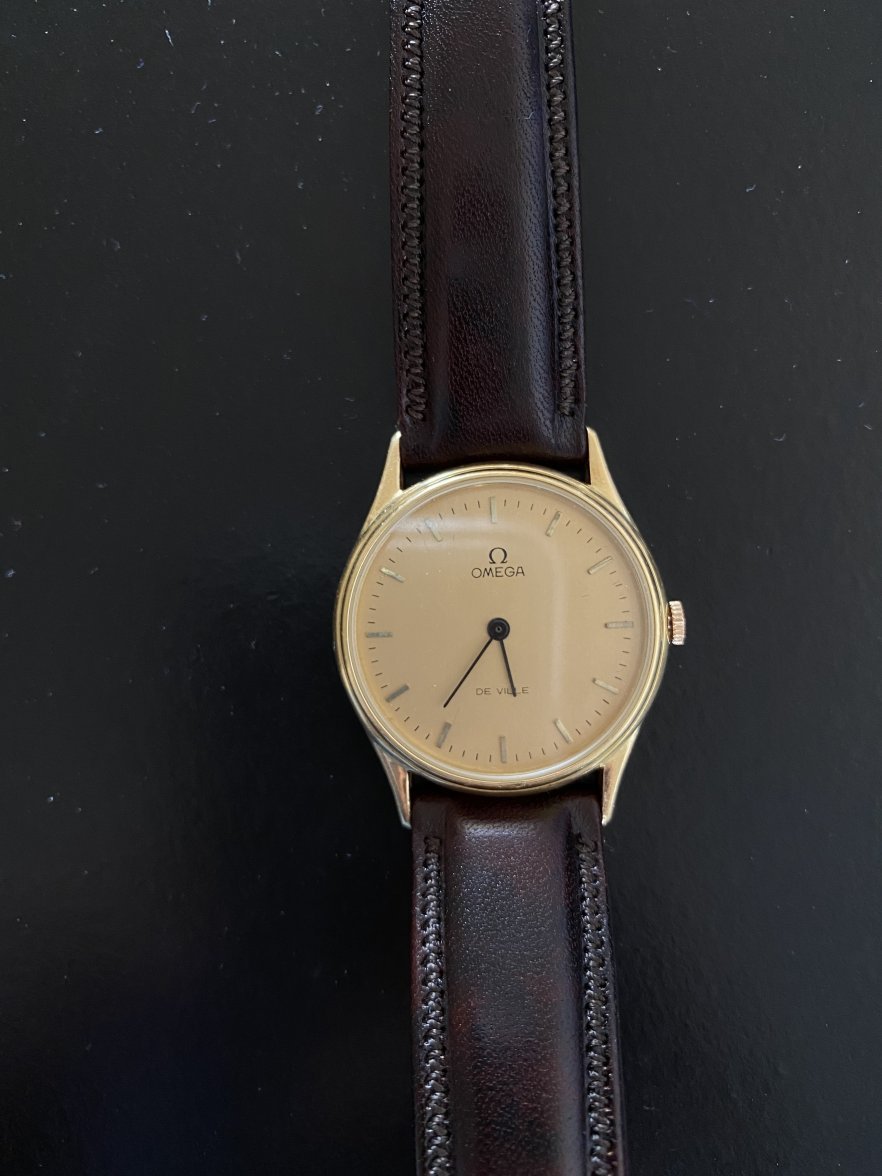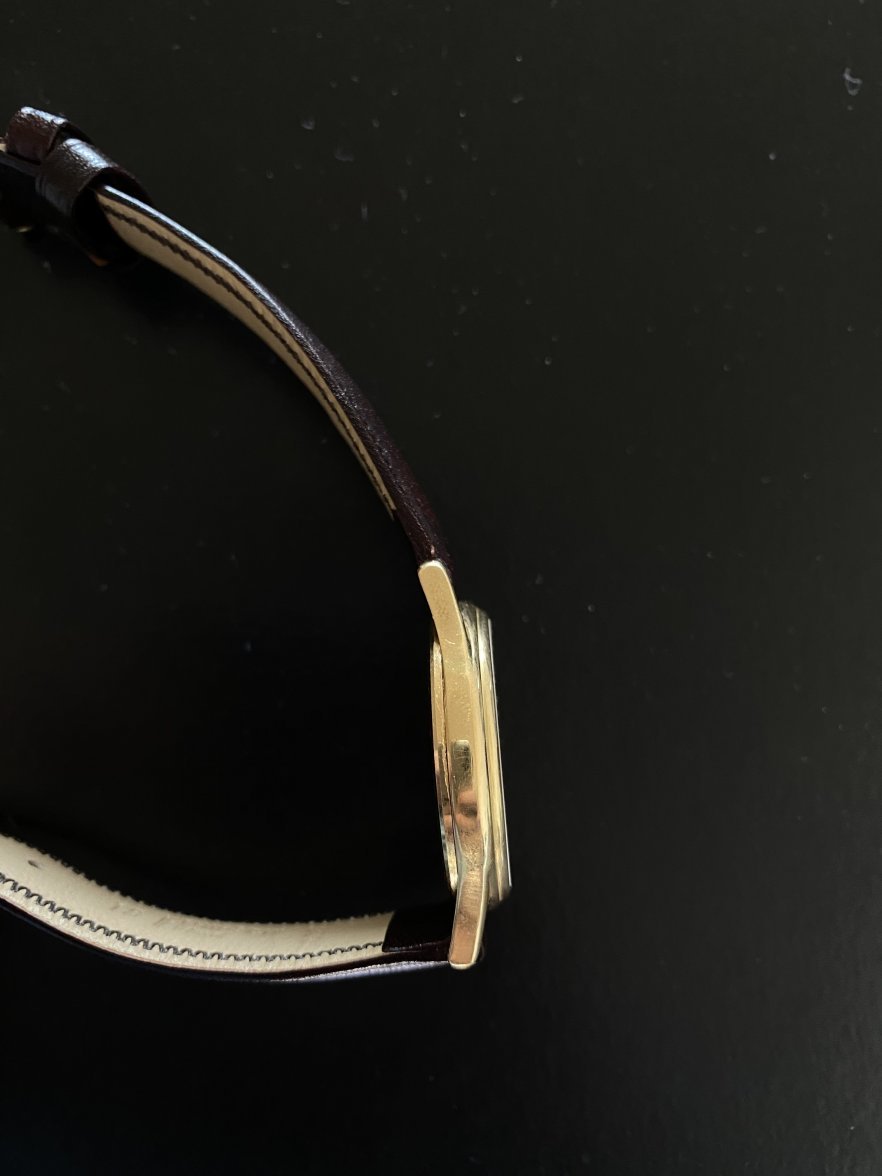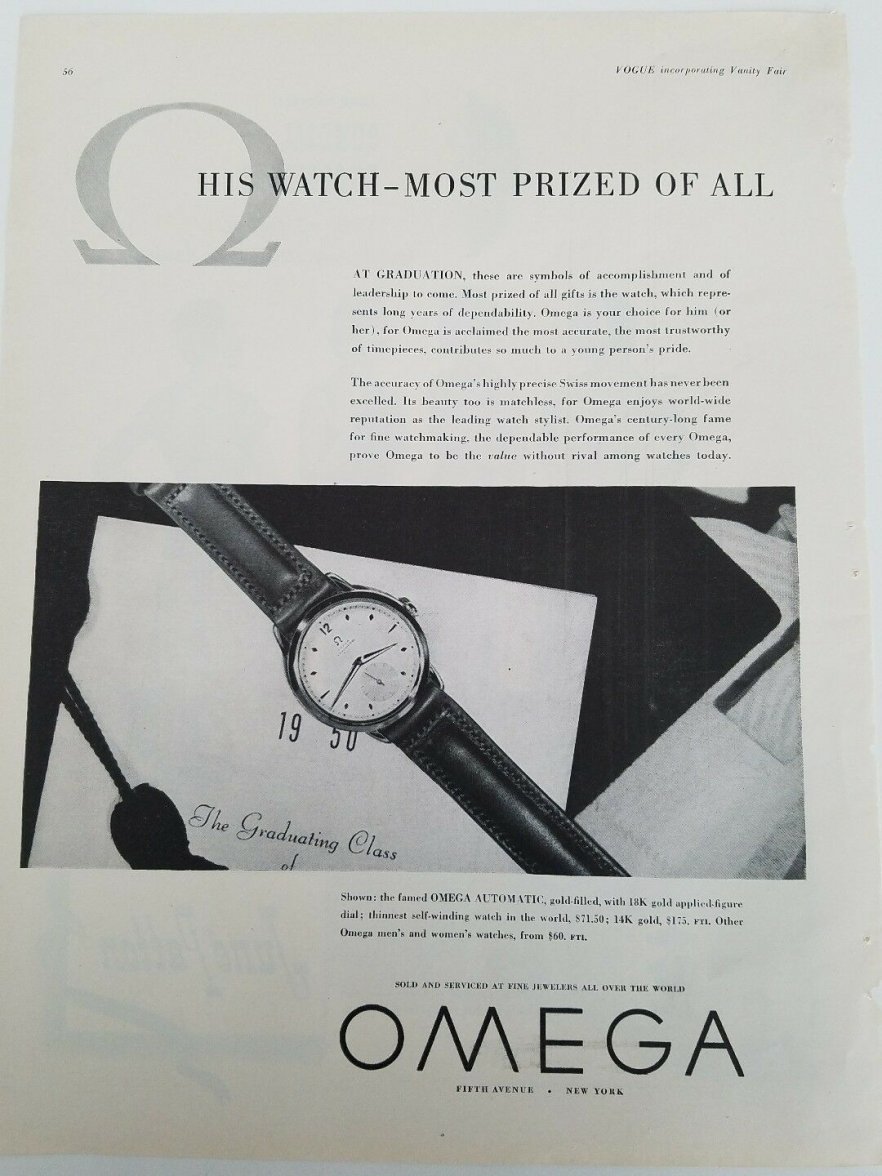GenevaFinder
·Hi everybody,
Happy to join the forum with this first thread today. Looks like a great community for Omega enthusiasts like myself.
As a first post, I would like to solicit your collective expertise to solve a mystery that's more than a decade old.
Context
I got what looks like a vintage De Ville for my first communion, a good 15 years ago. It remained in the safe for most of the period since then, as going around with what I'm pretty sure is a gold dress watch wasn't necessarily what I wanted when in high school and college.
Now that I am a horologically-inclined, Geneva-based young professional, I am keener to wear what I actually find to be quite a gorgeous piece. Half of my office wears Pateks, Audemars, and Jaegers, so it's not like I'm gonna shock anybody. If anything, I find my watch to be more tasteful.
Problem
The fact is however that I have strong suspicions when it comes to this timepiece. I'm quite sure it's fake, as a matter of fact. It doesn't really matter, since the piece will always hold sentimental value. As I said, I also find it quite attractive and elegant.
I would nonetheless like to ascertain its authenticity. I have been hunting the internet for similar examples, without success.
The watch itself
As you can see on the picture attached, the watch is a very simple, 18k gold (of this I am quite sure), De Ville. It's wonderfully small, at 30mm (my tiny wrist is pleased). If I'm not mistaken, the design of the hands and the typography of the "Omega" logo seems to point at a watch from the 70s or 80s, or an imitation thereof. The strap is of course not original. The case is in close to pristine condition, although the minute hand has suffered some damage, possibly suffering from the lack of dexterity of an amateur watchmaker in Spain.
I am not showing the caseback because it is for sure not original. It is commonplace in Spain to replace the caseback of watches given as first communion gifts with a blank one, engraved with the date of the first communion, the name of the first communicant, and the name of the gifter. Nevertheless, the caseback is quite clearly made out of yellow gold and beautifully engraved. This interesting because it gives credit to the jeweler's claim on the watch box, which announces that it is 18k gold. The rest of the case matches the caseback perfectly. The fact that its yellow shine hasn't been suffered one bit after almost two decades without being cared for also seems to confirm this is gold. Furthermore, I once opened the caseback to see the movement. I dented the caseback quite severely on that occasion (which is the reason why I am reticent to open it again to show here on this occasion).
The automatic movement itself is copper-plated, as I understand vintage Omega movements should be. It keeps pretty decent time. The power reserve seems to stand at a respectable 18 to 24 hours. Please pay no attention to the crown, as I broke and got it replaced myself.
My suspicions
My suspicions are first and foremost motivated by the lack of any "Swiss made" indications on the dial. The fact that the minutes hand has quite clearly been tampered with or been poorly assembled also disturbs me, as does the fact that I cannot find the model online. Furthermore, my uncle, who lovingly gave the watch to me, is completely unfamiliar with the world of horology (that's an understatement). He would have been quite easy to convince that the watch was authentic, or that its origin did not matter much. The lack of an original box or papers is also a source of suspicion, of course.
I nevertheless know that De Villes were a very common thing in the provincial part of Spain in which the watch was purchased and gifted to me. My dad has two very similar (quartz) De Villes from the 80s. I can perfectly picture some local lawyer or doctor purchasing my watch new in the 70s or 80s, only for his inheritors not to understand its worth upon his death in the early 2000s and sell it to the local jeweller. The fact is however that the watch would most likely have been the most prized possession of its provincial Spanish gentleman owner, no doubt. I find it hard to believe that the watch would show no signs of wear in such circumstances. One would not have spent a bucketload of pesetas on a watch not to wear it. To the contrary, the watch being 18k gold could also point at a dress watch used exceptionally. It may also have been easy for the jeweller to polish imperfections out of the soft material case.
I am confused. Please share your thoughts on what I think is at least an interesting mystery. Real or fake, I will love this watch no matter what. Thank you for your help as I try to determine its true nature!
Happy to join the forum with this first thread today. Looks like a great community for Omega enthusiasts like myself.
As a first post, I would like to solicit your collective expertise to solve a mystery that's more than a decade old.
Context
I got what looks like a vintage De Ville for my first communion, a good 15 years ago. It remained in the safe for most of the period since then, as going around with what I'm pretty sure is a gold dress watch wasn't necessarily what I wanted when in high school and college.
Now that I am a horologically-inclined, Geneva-based young professional, I am keener to wear what I actually find to be quite a gorgeous piece. Half of my office wears Pateks, Audemars, and Jaegers, so it's not like I'm gonna shock anybody. If anything, I find my watch to be more tasteful.
Problem
The fact is however that I have strong suspicions when it comes to this timepiece. I'm quite sure it's fake, as a matter of fact. It doesn't really matter, since the piece will always hold sentimental value. As I said, I also find it quite attractive and elegant.
I would nonetheless like to ascertain its authenticity. I have been hunting the internet for similar examples, without success.
The watch itself
As you can see on the picture attached, the watch is a very simple, 18k gold (of this I am quite sure), De Ville. It's wonderfully small, at 30mm (my tiny wrist is pleased). If I'm not mistaken, the design of the hands and the typography of the "Omega" logo seems to point at a watch from the 70s or 80s, or an imitation thereof. The strap is of course not original. The case is in close to pristine condition, although the minute hand has suffered some damage, possibly suffering from the lack of dexterity of an amateur watchmaker in Spain.
I am not showing the caseback because it is for sure not original. It is commonplace in Spain to replace the caseback of watches given as first communion gifts with a blank one, engraved with the date of the first communion, the name of the first communicant, and the name of the gifter. Nevertheless, the caseback is quite clearly made out of yellow gold and beautifully engraved. This interesting because it gives credit to the jeweler's claim on the watch box, which announces that it is 18k gold. The rest of the case matches the caseback perfectly. The fact that its yellow shine hasn't been suffered one bit after almost two decades without being cared for also seems to confirm this is gold. Furthermore, I once opened the caseback to see the movement. I dented the caseback quite severely on that occasion (which is the reason why I am reticent to open it again to show here on this occasion).
The automatic movement itself is copper-plated, as I understand vintage Omega movements should be. It keeps pretty decent time. The power reserve seems to stand at a respectable 18 to 24 hours. Please pay no attention to the crown, as I broke and got it replaced myself.
My suspicions
My suspicions are first and foremost motivated by the lack of any "Swiss made" indications on the dial. The fact that the minutes hand has quite clearly been tampered with or been poorly assembled also disturbs me, as does the fact that I cannot find the model online. Furthermore, my uncle, who lovingly gave the watch to me, is completely unfamiliar with the world of horology (that's an understatement). He would have been quite easy to convince that the watch was authentic, or that its origin did not matter much. The lack of an original box or papers is also a source of suspicion, of course.
I nevertheless know that De Villes were a very common thing in the provincial part of Spain in which the watch was purchased and gifted to me. My dad has two very similar (quartz) De Villes from the 80s. I can perfectly picture some local lawyer or doctor purchasing my watch new in the 70s or 80s, only for his inheritors not to understand its worth upon his death in the early 2000s and sell it to the local jeweller. The fact is however that the watch would most likely have been the most prized possession of its provincial Spanish gentleman owner, no doubt. I find it hard to believe that the watch would show no signs of wear in such circumstances. One would not have spent a bucketload of pesetas on a watch not to wear it. To the contrary, the watch being 18k gold could also point at a dress watch used exceptionally. It may also have been easy for the jeweller to polish imperfections out of the soft material case.
I am confused. Please share your thoughts on what I think is at least an interesting mystery. Real or fake, I will love this watch no matter what. Thank you for your help as I try to determine its true nature!



